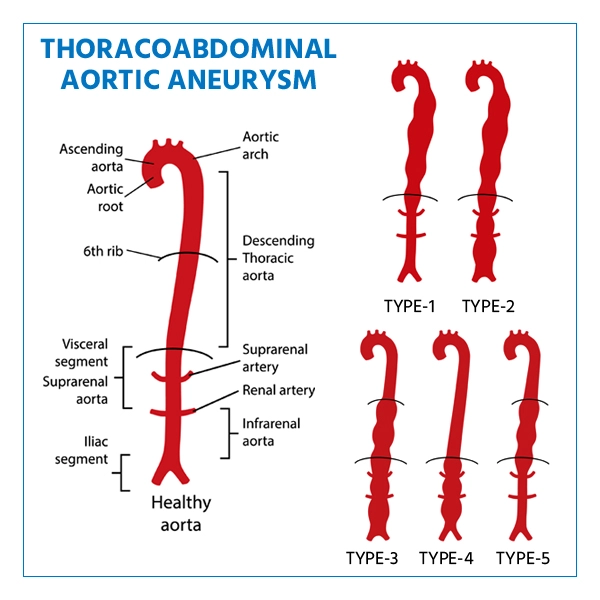Aortic Aneurysm Symptoms
Thoracoabdominal aortic aneurysms commonly develop without symptoms, but some may include:
- Pulsating lump in the abdomen
- Intense pain in the abdominal, chest or lower back which develops unexpectedly
Aortic Aneurysm Causes
The most prevalent cause of thoracoabdominal aortic aneurysms is atherosclerosis, which is the stiffness of the arteries caused by plaque formation. This plaque can stiffen and damage the aorta's walls over time, increasing the chance of an aneurysm formation.
Some of the risk factors for atherosclerosis and thus for developing a thoracoabdominal aortic aneurysm are:
- Smoking
- High blood pressure
- High cholesterol
- Overweight
- Family history of cardiovascular disease
Other risk factors for developing thoracoabdominal aortic aneurysm include:
- Old age
- Gender (Males are more likely to be affected than females)
- Family history of aneurysm
- Diabetes
- Marfan syndrome, Ehlers-Danlos syndrome, and Loeys-Dietz syndrome are examples of genetic disorders affecting connective tissue.
- Aortic infection or injury
Diagnosis
After reviewing your complete medical history and performing a physical exam, your doctor may request any of the following tests:
- CT (computed tomography) scan
- MRI (magnetic resonance imaging) scan
- Angiography
- Echocardiography
Treatment
Close Monitoring Period
During the "close monitoring" period, the vascular surgeon will perform a series of CT or MRI scans or ultrasounds to monitor the aneurysm's growth every 6 - 12 months. Once an aneurysm has grown to a significant size and is at risk of bursting, the surgeon might perform the procedure. The benefits of repairing the aneurysm outweigh the risks and complications of the surgery.
When an aneurysm reaches a size that places it at risk of rupture, the surgical alternatives are evaluated based on several criteria, including:
- Age of the patient, previous medical and surgical history, and present health status
- Age of the patient, previous medical and surgical history, and present health status
- Type, location, and size of an aneurysm
- Anatomy of the aorta and the arteries that branch off it to the visceral organs and the legs
The type of procedure used depends on the patient's medical condition and the aneurysm's characteristics.
Conventional Open Procedure
An abdominal aortic aneurysm needs opening the abdominal cavity and stitching a synthetic graft inside the aneurysm to the artery above and below it to prevent the aneurysm from collapsing while relining the weaker aorta with a material sleeve to bolster the aorta.
Endovascular Repair
Endovascular repair is a recent method that involves inserting a catheter into the groin. The catheter is used to place a self-expanding stent graft into the aneurysm, similar to an aortogram. Endovascular aneurysm treatment does not require a major incision and has a significantly quicker recovery time than conventional open surgery. Endovascular repair is not appropriate for all aneurysms.

